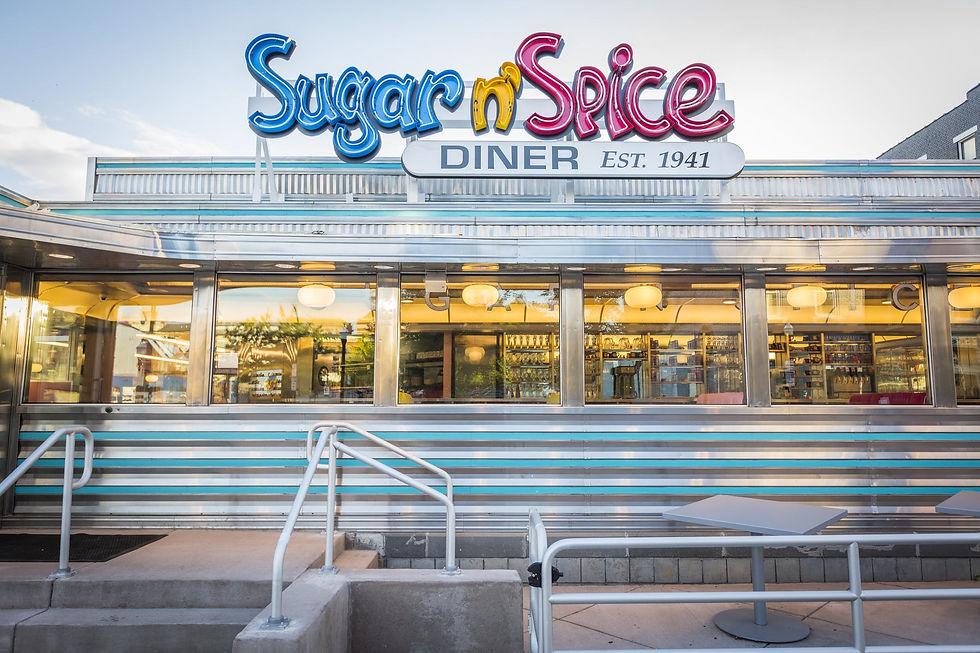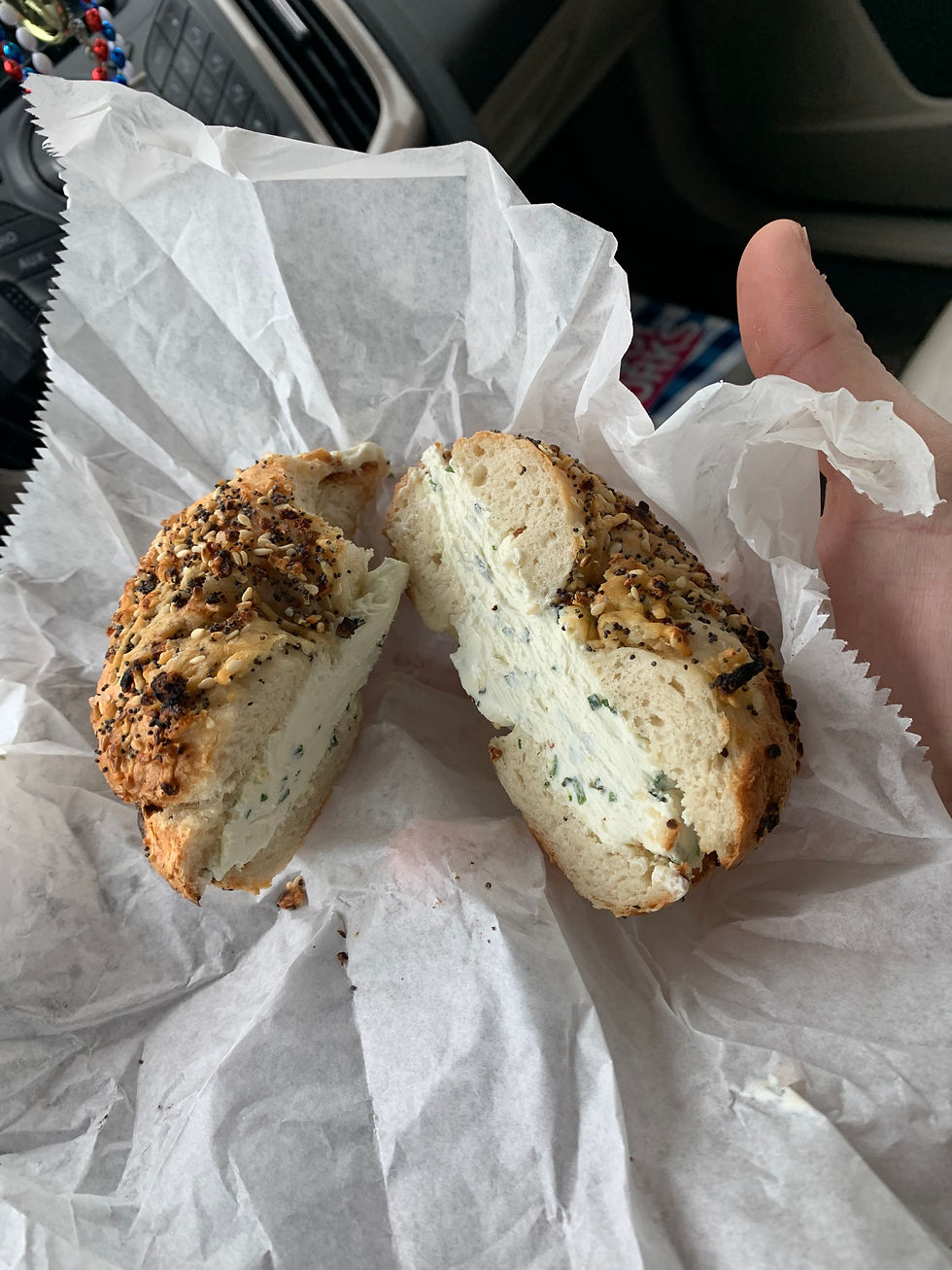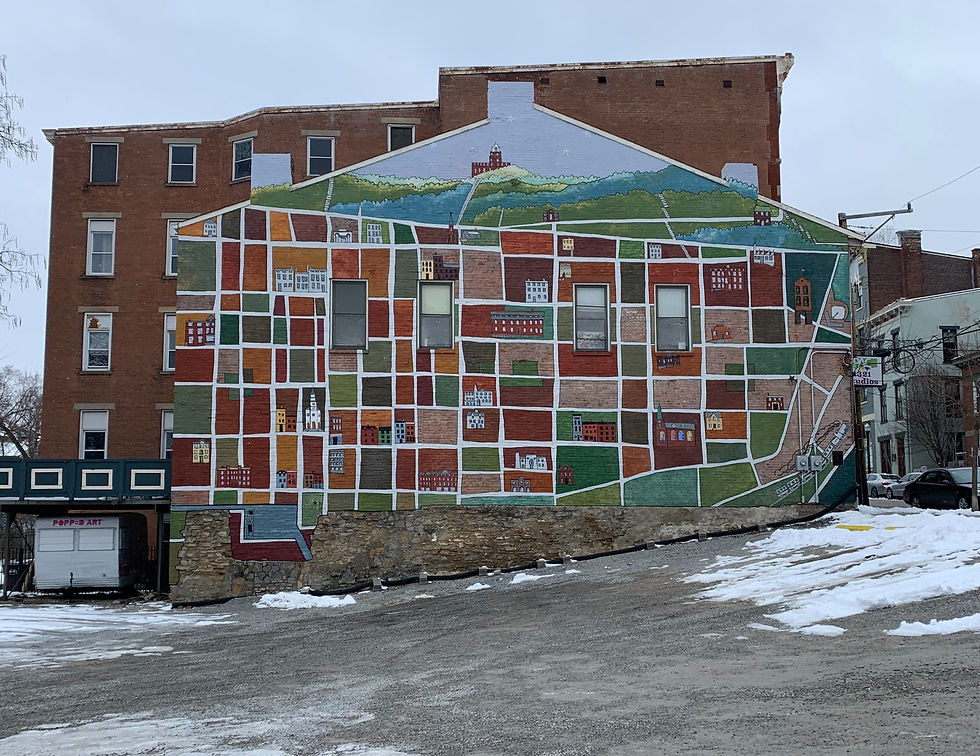Over-the-Rhine and Pendleton
- Anthony Gustely

- Mar 16, 2021
- 5 min read

It's week 12 of 52 First Impressions and I'm now almost half way through my visits of Cincinnati's 52 neighborhoods! This week I stayed close to downtown, visiting the well-known Over-the-Rhine neighborhood and the lesser known former art district, the Pendleton neighborhood. Although geographically small, both neighborhoods are incredibly interesting with rich art, history, and cultural roots.
Over the Rhine
Cincinnati natives and beyond will know that the Over-the-Rhine neighborhood has been quintessential to Cincinnati's history from the beginning. In the mid-19th century, Cincinnati experienced a population boom of immigrants, mostly German, who settled in the Over-the-Rhine area close to the factories and industry in downtown. The German working class that settled in the OTR area nicknamed the Miami Erie Canal (now Central Parkway) the "Rhine River". Thus, the area across the Rhine where the Germans lived became known as the area "over-the-Rhine".
OTR's "golden age" was a period in the Nineteenth and early Twentieth Century when it was the epicenter of Cincinnati's working-class social life. Vine St. alone was home to over 130 taverns. The neighborhood was full of saloons, beer gardens, restaurants, and theaters that catered to tastes ranging from "legitimate" theatre to burlesque and Wild Bill Hickock's traveling show.
Through the 20th century, OTR experienced significant demographic and social changes. Both World Wars heightened hostilities towards the German residents of OTR.
Over-the-Rhine's original culture took massive blows from Prohibition and WWI... Thousands of livelihoods and family businesses were destroyed. Combined with the anti-German hysteria produced by WWI, national policy and propaganda forever changed Over-the-Rhine. Major economic drivers were lost and German families moved to more assimilated neighborhoods.
During World War 2, OTR saw a boom in Appalachians moving to seek work in the coal and mining industries.
Over-the-Rhine remained a vibrant neighborhood in the early Twentieth Century, but the demographics started to change. Improved public transportation and cars made it easier for working-class families to live in the surrounding hilltop neighborhoods. People who could afford to leave OTR's densely packed, small apartment buildings moved away...OTR's building stock was outdated, and became home predominately to poor Appalachians who moved to the city from surrounding rural communities.
After the demolition of the Kenyon Barr neighborhood in the West end to make way for I-75, many African Americans relocated to OTR.
Reformers in the 1960's and '70s started "renovating" OTR's historic building stock by ripping out historic features and making apartments more energy efficient and easier to clean. By the 1980's, a vast number of the neighborhood's housing units were project-based Section 8. Residents no longer felt a connection to or pride in the neighborhood. Historic buildings were routinely razed while others started to fall into disrepair. Crime rose. Poverty increased.
Over-the-Rhine has been experiencing a resurgence for the past 10 to 15 years. It holds the title as one of the largest intact historic districts in the entire United States, and includes over 1,100 contributing buildings! Some of the most popular architectural styles found in OTR include muted Greek Revival, Italianate, and Queen Anne.

Over-the-Rhine is also home to some iconic Cincinnati landmarks, including Music Hall, Washington Park, Findlay Market, and more!
I started my day off at Sugar n Spice diner. It's a newer diner that opened on the border of Pendleton and OTR, and the Reading Road location has actually been open since 1941! The chrome-laden, single story building, built in 1983, is unique and doesn't fit in with the historic urban fabric of the area one bit. It's an eclectic change of pace to the ornate and often repetitive architectural styles within OTR!
I had heard great things about Sugar n Spice so I was definitely excited to try the food.
The diner serves mostly breakfast food and is known for their "wispy-thin" pancakes. I ordered the Breakfast Special with pancakes, over-medium eggs, and sausage. When I tell you that these were quite possibly the best pancakes I've ever had in my life, it is not an exaggeration.


I definitely recommend making your way down to OTR to try Sugar n Spice sometime. My meal was relatively cheap also (I want to say it was around $12 for my food and coffee!). Also, after your meal you get to pick out a rubber duck for free, so definitely check it out.

My next stop in Over-the-Rhine was Findlay Market. Built in 1852, Findlay Market is actually the only one of nine indoor markets open in 1859 that are still open today. Findlay Market is open year-round, Tuesday-Sunday, and includes "50 full-time merchants selling meat, fish, poultry, produce, flowers, cheese, deli, ethnic foods and more". It was cold and snowy when I visited, however, some of my favorite memories in OTR have been summer days walking around a bustling Findlay Market. I hope soon that the atmosphere and energy of a crowded market with people of all ages walking around, eating out on the patio furniture, and relaxing can be recreated.


I wanted to eat at a place I hadn't been before in Findlay Market, so I decided to try OTR Bagel Bar. The store has a shop facing the indoor market section, and features some pretty unique bagel flavors including pretzel, fruity pebbles, Cinnamon Toast Crunch, flamin' hot Cheeto, and grippos!


I decided to play it somewhat safe and got an everything bagel with herbed cream cheese. The bagel was honestly amazing, packed with flavor and a superior cream cheese to bagel ratio. It's affordable, too: I think I paid around $3/4 for my bagel with cream cheese.
Although I only visited a couple places in the neighborhood, there honestly is SO MUCH to do in Over-the-Rhine. For any of my beer lovers, some of my favorite OTR breweries include Rhinegeist, Rosedales, and even Pins Mechanical Company. Pins is actually where I got this priceless sunset-photo-to-end-all-sunset-photos, I don't know how this was shot on an iPhone to be quite honest.

Pendleton
Sitting immediately east of OTR, Pendleton is a small neighborhood that is oft referred to as the Pendleton Art District. Despite being less than 0.1 square miles in area and having a population of around 900, Pendleton is filled with local businesses, residential homes and apartments, and a plethora of public art. Most of these public art works are done by Artworks Cincinnati, a nonprofit focusing on building creative works of art throughout the city. All three of the ArtWorks murals in the neighborhood occupy walls of buildings that overlook parking lots:


Pendleton is one of those neighborhoods that if you haven't been to, you could walk it in 30 minutes and never be bored. Another arts-based connection linked to Pendleton is the Pendleton Arts Center, which boasts the title of the world's largest collection of artists under one roof (200+). Occupying the former Krohn-Fecheimer Shoe Company factory (built in 1909), the Center has eight floors of studios featuring original pine floors and eight foot arched windows.


I capped my visit at Urbana Cafe, a local coffee shop that got it's start in Findlay Market. Rooted in sustainability, Urbana Cafe features coffee and small bites. I kept it simple and got a regular latte, and sure as heck it tasted like a latte. If I ever had more time to spend down in Pendleton, I would definitely go to Urbana Cafe to study or do some homework!

Some of my favorite restaurants are located in Pendleton: Boomtown Biscuits, Lucius Q, and Pendleton Parlor are all within walking distance of each other on Broadway Street. Although small, there's plenty to do within Pendleton!

Thanks for reading this week! Next week I'm making my way closer to campus, visiting Mt. Auburn and Corryvillle! See you soon :)
Additional Links
cincinnati.com, This grand OTR experiment is about all of us - This article details the dichotomy of class disparity between long-time community residents of OTR and the demographic shifts stemming from gentrification within the neighborhood.








Comments